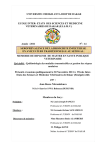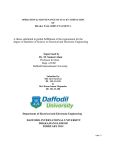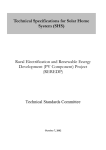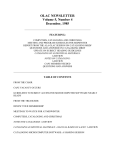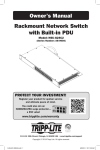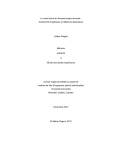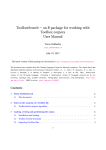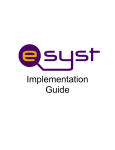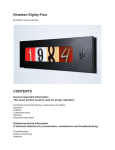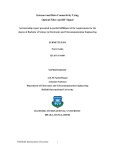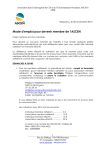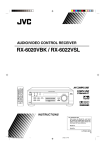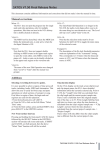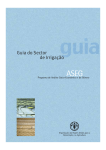Download Building and operating a mini-hatchery: Sand method
Transcript
Building and operating a mini-hatchery: Sand method International Fund for Agricultural Development Via Paolo di Dono, 44 00142 Rome, Italy Tel: +39 06 54591 Fax: +39 06 5043463 E-mail: [email protected] www.ifad.org www.ruralpovertyportal.org Palli Karma-Sahayak Foundation (PKSF) Bhaban Plot: E-4/B, Agargaon Administrative Area Sher-e-Bangla Nagar Dhaka 1207 Bangladesh Palli Karma-Sahayak Foundation The opinions expressed in this publication are those of the authors and do not necessarily represent those of the International Fund for Agricultural Development (IFAD). The designations employed and the presentation of material in this publication do not imply the expression of any opinion whatsoever on the part of IFAD concerning the legal status of any country, territory, city or area or of its authorities, or concerning the delimitation of its frontiers or boundaries. The designations “developed” and “developing” countries are intended for statistical convenience and do not necessarily express a judgement about the stage reached by a particular country or area in the development process. Cover: ©IFAD/G.M.B. Akash For more information, to comment or to share your experience and knowledge of simple mini-hatcheries, please contact: Antonio Rota Senior Technical Adviser, Livestock and Farming Systems Policy and Technical Advisory Division IFAD E-mail: [email protected] Photos in the text are from the video Mini-hatchery by Sayeed Kazol. or ISBN 978-92-9072-274-8 © 2011 by the International Fund for Agricultural Development (IFAD) S.M. Rajiur Rahman Training Officer, MFTS Project PKSF, Bangladesh E-mail: [email protected] September 2011 Table of contents About this manual 2 Acknowledgements 2 Introduction 3 Equipment and facilities needed for a sand-based mini-hatchery 5 Operating the mini-hatchery 7 Annex I: A business plan of sand-type mini-hatchery 15 Annex II: Candling eggs 17 Additional reading 19 About this manual Backyard poultry production is an important source of income and nutrition for the rural poor in the developing world. The foundation of this system is a regular supply of chicks and ducklings. This manual describes: • How to make a sand-type mini-hatchery; • How to collect and select fertile eggs; • How to place the eggs in the incubator; • The day-to-day operation of the hatchery; and • How to handle chicks or ducklings as they hatch. The manual is aimed at both extension agents and backyard poultry rearers. Acknowledgements This manual was prepared by S.M. Rajiur Rahman, Training Officer, Microfinance and Technical Support Project, Palli Karma-Sahayak Foundation, Bangladesh. The author is grateful to the Policy and Technical Advisory Division (PTA) of the International Fund for Agricultural Development (IFAD) for financial support and other services without which this manual could not have been prepared. The author is grateful to Antonio Rota, IFAD Senior Technical Adviser, Livestock and Farming Systems, PTA for his cooperation and important suggestions in developing the manual. The author gratefully acknowledges the following for their assistance in preparing the manual and producing the video: • Nigel Brett, IFAD Country Programme Manager • Fazlul Kader, Deputy Managing Director (Operation), Palli Karma-Sahayak Foundation, Bangladesh • Sarah Jesmin, Project Coordinator, Microfinance and Technical Support Project, Bangladesh • Kazi Abdul Fattah, Livestock Coordinator, Microfinance and Technical Support Project, Bangladesh • Beneficiaries of the IFAD-supported Microfinance and Technical Support Project who have established mini-hatcheries in the Districts of Kishoreganj of Bangladesh Special thanks go to the following technical peer reviewers: • Shabbir Ahmed Chowdhury, Director, Microfinance, Bangladesh Rural Advancement Committee International, Bangladesh • Mohammad A. Saleque, Senior Adviser, Agriculture and Livestock, Bangladesh Rural Advancement Committee International, Bangladesh • Olaf Thieme, Livestock Development Officer, Animal Production and Health Division, Food and Agriculture Organization of the United Nations, Rome • Emmanuel B. Sonaiya, Department of Animal Science, Obafemi Awolowo University, Ile-Ife, Nigeria The author wishes to thank Paul Neate for editing the manual. 2 Introduction Mini-hatcheries, or incubators, have been used to hatch chicken and duck eggs in Egypt and China for some 3,000 years. Mini-hatcheries have been in use in Bangladesh since the 1970s. In 1992, BRAC – a Bangladesh-based non-governmental organization – started a programme to promote the use of an incubator based on heated rice husk. However, the system was not widely adopted, largely because of poor management of fertile eggs in the supply chain. With financial support from the International Fund for Agricultural Development (IFAD), the Palli Karma-Sahayak Foundation (PKSF) expanded the conventional incubation process, producing a more efficient and functional system, building on an adapted, comprehensive training programme that covered all aspects of the rural poultry production chain. In particular, a four-week practical training programme for rural women was developed and carried out by a livestock agent at the village level. Mini-hatcheries can be constructed from cheap materials available locally, such as rice husk, quilts and sand, to retain heat. The incubators can be easily made using readily available skills and tools. Sand-based mini-hatcheries give the highest hatching percentages for both chicken and duck eggs (80-85 per cent and 70-72 per cent respectively, compared with 70-75 per cent and 65-68 per cent for rice husk incubators and 75-80 per cent and 60-62 per cent for rice husk and quilt incubators. As a result, sand-based incubators are gaining popularity. The advantages and disadvantages of the different types of incubators are shown in the Table below. This manual aims to provide people with the skills and knowledge needed both to construct sand-based incubators and to operate them efficiently. 3 Advantages and disadvantages of different types of small-scale incubators for hatching chicken and duck eggs Parameter Electric incubator Sand method Rice husk method Rice husk and quilt method Electricity Required Not required Not required Not required Equipment Sophisticated modern equipment Local/traditional materials Local/traditional materials Local/traditional materials Installation in remote areas Cannot be installed in areas without electricity Can be installed in remote areas where electricity is not available Can be installed in remote areas where electricity is not available Can be installed in remote areas where electricity is not available Installation cost Highest Lowest Higher than sand method but much lower than electric incubator Higher than sand and rice husk methods but much lower than electric incubator Maintenance cost Highest Lowest Higher than sand method Higher than sand and rice husk methods but lower than electric incubator Temperature regulation Automatic Easier than rice husk and quilt method More difficult than sand and rice husk and quilt method Easier than rice husk method Humidity regulation Automatic Manual Manual Manual Hatching percentage (chicken eggs) 80-85% 80-85% 70-75% 75-80% Fuel cost Highest Lowest Higher than sand method Higher than sand and rice husk method Users Only wealthy people can afford this system All, including landless and resource-poor households in marginal areas All, including landless and resource-poor households in marginal areas All, including landless and resource-poor households in marginal areas 4 Equipment and facilities needed for a sand-based mini-hatchery To operate a sand-based mini-hatchery you need: • An incubator, including: • Kerosene lamps to heat the incubator • Thermometers to monitor temperature in the incubator • A water bowl to maintain humidity inside the incubator • Fertile eggs • Egg trays • Chick boxes • A candling box (see Annex II) • Antiseptic solution for washing the eggs and disinfecting the incubator • Somewhere to keep the incubator Building a sand-based incubator The incubator consists of a wooden cabinet lined with insulating material and equipped with trays to hold the sand (heat retention) and eggs. There should be a hatch in the top of the cabinet to allow hot air to be released to regulate the temperature inside the incubator. The size of the cabinet depends on the number of eggs to be incubated. An incubator of 135 cm tall, 230 cm wide and 105 cm deep can accommodate three hatching trays and incubate 1,200 to 1,500 eggs at a time. The cabinet should be made of wood. The walls, roof and doors should be lined with a layer of cotton wool (in rolls), 8-12 cm thick. The trays may be made of wood or metal. The trays rest on a rack made of wood or metal. The sand tray should be set 50 cm above the floor of the cabinet. The first hatching tray should be 15-20 cm above the sand tray, with each additional hatching tray set 15-20 cm above the previous tray (see diagram below). There should be a gap of 8 cm between the edges of the trays and the walls and doors of the cabinet to allow air to circulate. Width: 230 cm Depth: 105 cm Hatch Hatch 8-12 cm thick layer of cotton Width of trays: 56-61 cm Egg tray Egg tray 15-20 cm between trays 1.5-3.0 cm sand layer Height: 135 cm Egg tray ................................................................. .................................................................. .................................................................. Sand tray .................................................................. ................................................................. 50 cm Kerosene lamps 8 cm between tray and wall of the box Diagram of the sand-based incubator and its internal arrangement 5 A sand-based incubator with three hatching trays. The sand tray should be lined with black cloth to retain the sand and filled with a layer of sand, between 1.5-3 cm thick. The hatching trays should be lined with a layer of jute sacking and a black cloth. Hatchery room Ideally, the incubator should be kept in a room set aside for the hatchery. The room should be built using low-cost local materials (such as bamboo, stra.w, hardboard, polythene, etc.). It should have a door and windows that can be closed to help control the temperature in the room and hence in the incubator. Hatching trays lined with jute sacking and black cloth. 6 Operating the mini-hatchery Hatchery sanitation Good sanitation must be maintained to prevent disease in the hatchery. A good sanitation programme consists of 90 per cent good management and 10 per cent disinfection and fumigation. • Wash and disinfect the floor of the hatchery room every day. • Remove broken, infertile and spoiled eggs as soon as you see them. • When chicks and ducklings start to hatch, remove eggshells and weak or dead chicks immediately. • After all the eggs have hatched, remove the trays and cloth liners and wash and disinfect them thoroughly. The incubation process Chicken eggs hatch after 21 days, while duck eggs hatch after 28 days. DAY 1 Collect fertile eggs from breeding flocks where roosters and hens and drakes and ducks are kept together, with a ratio of at least one rooster or a drake for every 10 hens or ducks. Select well-shaped, standard-sized eggs. Clean the eggs and wash them with a mild antiseptic solution in hot water. Locally available household antiseptics such as Dettol® and Savlon® can be a used for this. Place the clean eggs in egg trays, put them in a sunny place and warm them to 100° F (37.5° C). Alternatively, warm them carefully over a kerosene stove. Eggs can be stored for up to 7 days at 59° F to 64.4° F (15° C to 18° C) and 75-80 per cent relative humidity before being placed in the incubator. Purchase eggs from nearby breeding flocks to minimize the distance the eggs must be transported. Take care to avoid damaging the eggs in transit and protect them from large changes in temperature. Warming eggs in the sun. 7 Place two or three lit kerosene lamps in the incubator and allow the temperature in the incubator to rise to 98° F to 100° F (36.5° C to 37.5° C). This should take 2 to 3 hours. The lit kerosene lamps must be clean and the operator should be careful to regulate the flame to avoid producing smoke, which would poison the embryos in the eggs. Once the incubator has reached the desired temperature, carefully arrange the warm eggs on the hatching trays. The eggs should be set at a 45° angle, with the narrower end pointing down. Arrange the eggs on the hatching trays, with the narrower end pointing down. a Place a bowl of water on the floor of the incubator to maintain humidity at Maintain the humidity in the incubation box at 70-80 per cent. Ideally, you should measure the humidity using a hygrometer. If the air in the incubation box is dry, the eggs will take longer to hatch. 70-80 per cent. Place a laboratory thermometer on each hatching tray and check the temperature every time you turn the eggs (6 to 8 hours). If the temperature falls below 98° F (36.5° C), increase the size of the flame of the kerosene lamps. If it rises above 100° F (37.5° C), open the hatch in the top of the incubator to release some hot air and reduce the flames in the lamps or remove one or more of the lamps. Ideally, monitor the humidity in the incubation box using a hygrometer. 8 DAYS 2 TO 18 (CHICKEN EGGS) AND DAYS 2 TO 24 (DUCK EGGS) Turn the eggs every 6 to 8 hours. Carefully turn the eggs every 6 to 8 hours. Continue turning the eggs until Day 18 for chicken eggs and until Day 24 for duck eggs. Check the temperature inside the incubator every time you turn the eggs to ensure that it is consistently between 98° F and 100° F (36.5° C to 37.5° C). If the temperature falls below 98° F (36.5° C), increase the size of the flame of the kerosene lamps. If it rises too high, open the hatch in the top of the incubator to release some hot air and reduce the flames in the lamps or remove one or more of the lamps. Remove and throw away any broken eggs. Add water to the water bowl in the incubator whenever it runs low. This is important to maintain the humidity in the incubator. 9 CANDLING THE EGGS: DAYS 7 AND 14 (CHICKEN EGGS), AND DAYS 7 AND 21 (DUCK EGGS) a Candle the eggs on Day 7 and Day 14 to identify infertile and spoiled eggs. Candling: Place a candle or electric light bulb inside a box with an egg-sized hole in the side. Place each egg in turn into the hole and observe the pattern of light shining through the shell. (See Annex II.) Remove all the infertile and spoiled eggs from the incubation chamber. After 7 days infertile eggs are still safe to eat, but spoiled eggs should be discarded. After 14 days, spoiled eggs need to be discarded. Some 75-90 per cent of eggs from a good breeding flock should be fertile. - Fertile egg: You will see a faint pattern of blood vessels. - Infertile egg: These are transparent, with no sign of blood vessels. - Spoiled egg: These are opaque. Candling an egg to check whether it is fertile. Check the temperature inside the incubator every time you turn the eggs (6 to 8 hours). It should be kept at 98° F to 100° F (36.5° C to 37.5° C). 10 DAY 19 (CHICKEN EGGS) Stop turning the eggs. Cracks are seen on the chicken eggshells. Once a day, gently moisten the eggs using a wet cotton cloth to soften the shell and help the chicks emerge. Initial hatching phase. DAY 20 (CHICKEN EGGS) Chicks will start to come out from the eggs. DAY 21 (CHICKEN EGGS) Most of the chicks will have hatched. If a chick is having difficulty getting out of the egg, wash your hands and then gently break the shell, taking care not to tear the chick’s umbilical cord. Remove chick gently from the egg taking care not to tear the umbilical cord. 11 Chicks are dry within 30 to 45 minutes after emerging from their shells. Once dry, they rapidly overheat in the incubator. Remove chicks as soon as they are dry and place them in a holding basket equipped with a heat lamp to keep them warm. Day-old chicks are now ready for the brooding phase. Day-old chicks from the hatchery are now ready for the next production phase: brooding. Remove eggshells, dead chicks and spoiled eggs from the hatching trays. Dispose of them hygienically, for example by burying them in the soil. Once all the chicks have hatched, remove the cloth linings from the hatching trays and clean and disinfect the incubator thoroughly so that it is ready for the next batch of eggs. Once all the chicks have hatched, clean the incubator thoroughly. 12 DAY 24 (DUCK EGGS) Stop turning the eggs. DAY 26 (DUCK EGGS) Cracks are seen on the duck eggshells. Gently moisten the eggs using the wet cotton cloth to soften the shell and help the ducklings to emerge. DAY 27 (DUCK EGGS) Ducklings start to hatch from the eggs. DAY 28 (DUCK EGGS) Most of the ducklings will have hatched from the eggs. Hatched ducklings. If a duckling is having difficulty getting out of the egg, wash your hands and gently break the shell, taking care not to tear the umbilical cord of the duckling. Remove duckling gently from the egg taking care not to tear the umbilical cord. 13 Ducklings dry within 30 to 45 minutes after emerging from their shells. Once dry, they rapidly overheat in the incubator. Remove the ducklings as soon as they are dry and place them in a holding basket equipped with a heat lamp to keep them warm. Day-old ducklings from the hatchery are now ready for the next production phase: brooding. Remove eggshells, dead ducklings and spoiled eggs from the hatching trays. Dispose of them hygienically, for example by burying them in the soil. Eggshells, dead ducklings and spoiled eggs should be buried. Once all the ducklings have hatched, remove the cloth linings from the hatching trays and clean the incubator thoroughly so that it is ready for the next batch of eggs. Remove cloth lining from the hatching trays before cleaning the incubator. 14 Annex I A business plan of sand-type mini-hatchery Incubator establishment costs Fixed costs Description Measurement/quantity Incubator Height 135 cm x width 230 cm x depth 105 cm Open weave tray 2 80/- Kerosene lamp, bulb 3 500/- Thermometer 3 50/- Black cloth 5m Cotton 10 kg Jute sacks 4 (estimate) 120/- Candler 1 150/- Water pot 1 100/- Marker 1 30/- Egg tray 20 500/- Chick box 5 750/- Total Approximate cost (BDT) United States dollars* 8 000/- 300/1 500/- 12 080/- 170 Approximate cost (BDT) United States dollars* * 1 US$ = 71 Bangladesh taka (BDT). Operational costs for incubating 600 eggs Description Measurement/quantity Chicken eggs Fertile eggs 600 eggs x 8.50 BDT per egg Kerosene, disinfectant, antiseptic solution, etc. Lump sum Total 5 100/600/- 5 700/- 80 Duck eggs Fertile eggs 600 eggs x 7.50 BDT per egg Kerosene, disinfectant, antiseptic solution, etc. Lump sum Total 4 500/800/- 5 300/- 75 * 1 US$ = 71 BDT. 15 Income per batch of 600 eggs Chick production Chicks hatched 510 (hatchability of 85 per cent) Chick sales 510 x 21 BDT per chick = 10 710 BDT (US$151)* Sale of edible eggs after first candling 70 infertile (edible) eggs x 5.5 BDT per egg = 385 BDT (US$5) Total sales 11 095 BDT (US$156) Net income 11 095 BDT – 5 700 BDT = 5 395 BDT (US$76) * 1 US$ = 71 BDT. Duckling production Ducklings hatched 432 (hatchability of 72 per cent) Duckling sales 432 x 18 BDT per duckling = 7 776 BDT (US$110)* Sale of edible eggs after first candling 70 infertile (edible) eggs x 5.5 BDT per egg = 385 BDT (US$5) Total sales 8 161 BDT (US$115) Net income 8 161 BDT – 5 300 BDT= 2 861 BDT (US$40) * 1 US$ = 71 BDT. Note: Depreciation of 150 BDT to 160 BDT (US$2) may be deducted from each batch income. This is based on total fixed cost for the incubator of 12,080 BDT, with an operational life of 10 years and utilization for 8 months per year, i.e. depreciation spread over 80 months. 16 Annex II Candling eggs Candling is the process of shining light through an egg to determine whether the egg is fertile, infertile or spoiled. The manual recommends candling on Day 7 and Day 14 for chicken eggs, and Day 7 and 21 for duck eggs. The principle is simple: In a dark room a source of light is placed against the eggshell, and the light passes through illuminating its contents. If the egg is fertile a tiny network of blood vessels emerging from a dark red spot (similar to a spider) will be seen (see photo below). If the egg is infertile the yolk will appear as a floating shadow with no sign of blood vessels. And if the egg is spoiled it will appear opaque. A candler can be easily made by using a 25 to 60 Watt light bulb (if electricity is available) or a candle placed in a container (small box or empty tin can), with a hole (3-4 cm) to let the light pass through (Figure 1). A battery torch can also be used with a box or tin can placed on top and the egg positioned over a hole to allow the light to shine through (Figure 2). Remember: • Always handle the eggs with care and do not keep them out of the incubator for more than 10 to 15 minutes. • Infertile chicken eggs at Day 7 can be consumed, while infertile chicken eggs at Day 14 must be disposed of hygienically. Figure 1. Candler using a light bulb Figure 2. A torch candler Egg Light Box or tin can Torch 17 Additional reading Card, L. E., and M.C. Nesheim. 1972. Poultry production (11th ed., reprinted). Philadelphia, USA: Lea & Febiger. Khan, M.A. 1983. Dim Prashfutaner Katha. [A book on the principles of duck hatchery operation]. Friends in Village Development of Bangladesh, Khadim Nagar, Sylhet, Bangladesh. Khan, M.S.R., and K.S. Farid. 2011. Study on the technical and financial aspects of mini- hatcheries (for chicken and duck) and poultry model breeders including diseases associated with the production in the two systems. Research report submitted to the Microfinance and Technical Support Project, Palli Karma-Sahayak Foundation (PKSF). Dhaka, Bangladesh: PKSF. Nahar, J., K.A. Fattah, S.M. Rajiur Rahman, Y. Ali, A. Sarwar, E. Mallorie, and F. Dolberg. 2006. The rice husk hatchery in the microfinance and technical support project in Bangladesh. INFPD Newsletter 16(2):27–29. Rajiur Rahman, S.M. 2008. Family poultry development through micro-credit and technical support. World’s Poultry Science Journal 64(2). Rota, A., N. Brett, J. Nahar, S.M. Rajiur Rahman, Y. Ali, A. Sarwar, and K.A. Fattah. 2006. The experience with mini-hatcheries technology in Bangladesh. Available at: http://www.enrap.org/events/ifad-events/ifad-fao-study-tour-on-microfinance-for-marginaland-small-farmers-reaching-the-target-group-2/Paper - Mini-hatcheries poultry.doc Sumy, M.M.C., and M.M Islam. 2010. Study on the viability and profitability of improved backyard poultry enterprises in the poultry model chain in Bangladesh. Research report submitted to the Microfinance and Technical Support Project, Palli Karma-Sahayak Foundation (PKSF). Dhaka, Bangladesh: PKSF. 19























